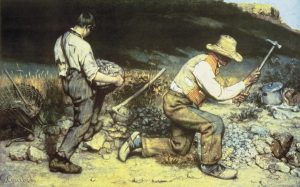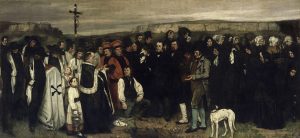Gustave Courbet, The Stone Breakers
The leading figure of the Realist movement in nineteenth-century art was Gustave Courbet (1819-1877). The Realists’ sincerity about scrutinizing their environment led them to paint mundane and trivial subjects that artists had traditionally deemed unworthy of depiction – for example, working-class laborers and peasants, and similar “low” themes. Moreover, by depicting these subjects on a scale and with a seriousness previously reserved for historical, mythological, and religious painting, Realist artists sought to establish parity between contemporary subject matter and traditional themes of “high art.”

An early work that exemplifies Courbet’s championing of everyday life as the only valid subject for the modern artist is The Stone Breakers, in which the Realist painter presented a glimpse into the life of rural menial laborers. Courbet represented in a straightforward manner, and nearly at life size, two men – one about 70, the other quite young – in the decidedly nonheroic act of breaking stones to provide paving for provincial roads. Traditionally, this backbreaking, poorly paid work fell to the lowest members of French society, as the stone breakers’ tattered garments and utensils for modest meal of soup confirm. The artist neither romanticized nor idealized the men’s work but depicted their thankless toil with directness and accuracy. Courbet’s palette of dirty browns and grays further conveys the dreary and dismal nature of the task.

PAVILION OF REALISM
The academic jury selecting work for the 1855 Salon rejected 3 of the 14 paintings that Courbet submitted (including Stone Breakers and Burial at Ornans), declaring that his subjects and figures were too coarse and too large. In response to the jury’s decision, Courbet withdrew all of his works, including those that had been accepted, and set up his own exhibition outside the grounds, calling it the Pavilion of Realism, featuring 40 of his own works. This was in itself a bold action. Courbet was the first artist ever known to have staged a private exhibition of his own work.
Courbet’s most famous statement is his blunt dismissal of academic painting, in which he concisely summed up the core principle of Realist painting: “I have never seen an angel. Show me an angel, and I’ll paint one.”[1]
- Fred S. Kleiner, Gardner’s Art Through the Ages: The Western Perspective, vol. 2, 15th ed., (Boston: Cengage Learning, 2017), 696-697. ↵

